Introduction
Conducting and overseeing the effectiveness of business operations is a topic addressed by numerous authors in their research (Sainaghi et al, 2019; Osunsanwo and Dada, 2020; Tuan, 2020; Oliveira et al, 2021). They predominantly concern medium and large companies, where it is easier to apply or identify tools for such analyses. In small enterprises, the assessment of the effectiveness of functioning is sometimes more difficult and intuitive. Typical financial indicators used for this purpose do not always work. Therefore, those that concern various aspects of the company’s operation, including non-financial ones, become much more reliable (Osunsanwo and Dada, 2020).
Based on this assumption, an attempt was made to use such a tool as a Balanced Scorecard for measurement. It evaluates not only financial, but also many other aspects (Malagueño et al., 2018). In the first stage of the research, the results of which are presented in the following publication, an attempt was made to select factors that best describe all key areas of the company’s operations. Consequently, it was possible to establish lists of such factors and the connections between them. The mapping of factors was conducted in two forms. The first one was in line with BSC assumptions, i.e., divided into strategic, progress measurement and operational areas. The other included BSC’s four analytical perspectives, such as financial, customer, internal processes, and learning and development. In each form, an attempt was made to identify the most relevant factors from the point of view of the operation of the company under study.
BSC – four perspectives
The balanced scorecard was created based on the belief that the company’s achievements do not come down only to financial results, but they also include non-financial, qualitative aspects (Łada and Kozarkiewicz, 2007). The importance of such elements as flexibility in action, customer satisfaction and loyalty, or employee competence development is emphasized here (Massingham et al., 2019). BSC is described by four perspectives that form its foundation and are presented in Table 1.
Table 1. Characteristics of the perspectives that make up the Balanced Scorecard

Source: Authors’ own elaboration based on (Kaplan and Norton, 2001)
The first is the financial perspective. Financial measures provide the most quantifiable assessment of economic values and effects. They make it possible to determine precisely whether the implemented actions are bringing the company closer to achieving predetermined goals.
The success of the company is determined by the opinion and attitude of the customer. Satisfying their needs, offering high quality products or services and building customer loyalty makes it possible to establish and maintain the expected competitive position. This is the area of interest of the second perspective.
In the perspective of internal processes, performance measures should be focused on those that have the greatest impact on achieving financial goals as well as customer satisfaction. BSC also allows identifying and improving completely new processes, the implementation of which is sometimes crucial for the effective functioning of the company.
The last perspective focuses on growth. The basis for the long-term development of a company is access to the necessary resources and the ability to use them effectively. It is not enough to possess the resources; one should also have the ability to use them optimally. All the perspectives described are interdependent and balanced, as shown in Figure 1.
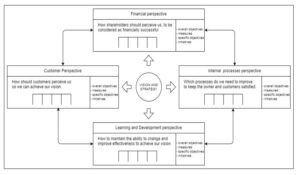
Figure 1. The four perspectives of the Balanced Scorecard and the
relationships between them
Source: Authors’ own elaboration based on (Kaplan and Norton, 2001)
Developing a Balanced Scorecard is a lengthy process that requires a lot of consultation, analysis and meetings. The process often involves people holding managerial positions in the key divisions of the company – people who strive for high results in their areas of responsibility. Therefore, the development should lead to consensus, follow a set procedure, and take place periodically, along with monitoring changes occurring in the company and its environment.
Research Methodology
The conducted research was primary, qualitative. The data were collected during work on the author’s bachelor’s thesis, between March and June 2021. The research methods used were standardized in-depth interview, Porter’s five forces analysis, PEST analysis, SWOT analysis, expert method and factor maps.
A standardized in-depth interview was adopted as the method for collecting data on the company. The interview was conducted with two respondents. This method was chosen due to its ability to conduct the interview in a structured manner, reducing the risk of omitting the issues of interest.
The research began with a literature analysis, allowing the collection of information on the sector, on the basis of which a survey questionnaire was prepared. Information about the analyzed company was obtained during a conversation held according to this questionnaire, in a way that allows the interviewee to deepen his or her speech. The interview was conducted with the president of the company and additionally with its employee. The information obtained enabled us to carry out data analysis and facilitated the research procedure.
The collected data and the information from the literature research allowed us to conduct an internal and external analysis of the company, after which we proceeded to synthesize the information obtained and create an ordered set of factors, according to the decision-making areas and perspectives of the Balanced Scorecard.
Company Description
Ośrodek Szkolenia Zawodowego (OSZ – The Vocational Training Centre) was established in Poznan in 1963 and currently consists of six contracted employees. Additional trainers are hired as needed. Since its foundation, there has been one succession of the company from father to daughter. She currently runs the company and her husband, and two sons also work for her. In the future, it is planned that one of them will take over the company. The company can therefore be regarded as a family business (Więcek – Janka, 2020).
The area of operation covers mainly Wielkopolska, occasionally customers from outside the region. Most often these are regular customers who, satisfied with the level of training, are willing to cover the cost of travel of OSZ employees to their headquarters. The OSZ has its own workshops and lecture halls with full equipment allowing for comprehensive implementation of training and vocational exams. The Centre is an accredited unit of UDT (Office of Technical Inspection).
The company under analysis operates using a combination of two business models. These are B2B (Business-to-Business) and B2C (Business-to-Customer). The main activity of the company is the provision of training and examinations in the area of qualifications for materials handling equipment, as well as in the area of equipment maintenance, welding and power engineering. These skills are essential for the operation of production plants or logistics halls. Directing the offer to such companies gives them the opportunity to establish lasting cooperation, regularity of training and, consequently, income. It is important to maintain such relationships because offers in the technical sector are difficult to communicate and require expert knowledge (Mazurek and Nosalska, 2018).
The company regularly trains about 200 people per month (Table 2.). This includes both in-company and in-house training. For years, business customers have been the majority over individual customers in the number of ordered and conducted training courses. We observe the seasonality of increased interest, occurring in the month of June and December. This is due to, in the first case, the approaching vacation season and, in the other case, the approaching end of the year.
Table 2. Number of people on the registry of people trained by OSZ
 Source: Authors’ own elaboration
Source: Authors’ own elaboration
Recently, we have observed an increase in the number of individual clients over companies sending employees for training. This behavior may be due to the higher fluctuation of workers in the market and an increased influx of workers from abroad, who must have a proof of qualifications in accordance with Polish law.
Research Results
The identification of BSC factors
The analysis of the competitive environment using Porter’s five forces method
The analysis began by identifying the threat from competitors (Isabelle, 2020). 15 organizations providing vocational training services located in the city of Poznan were identified. The owners of the OSZ are fully aware of the competition and they are able to point it out unerringly. This shows the good knowledge of the market, which is a great asset for the business. At the same time, the analysis of the number of training courses and students revealed that the OSZ has about 20% of market share which puts them in a very good competitive position.
The second force considered here in Porter’s analysis is the influence of suppliers. Since the firm is in the service business, suppliers are also defined as service providers, especially examiners. The most important are those who have the authority to examine and issue certificates of qualification.
The power of recipients’ influence is the basic element of building the competitive advantage here. The activity conducted by the OSZ is aimed at meeting the specific needs of the recipients. They are identified as two groups. The first are institutional customers who most often use the services of the enterprise because of the need to meet formal requirements in the field of the education of employed workers. The other one includes individuals who, in order to find and take up a job, need to acquire the appropriate formal credentials. For both, the level of education and the certificates documenting its completion are crucial.
Qualifications in the areas as specific as materials handling equipment, welding or power generation, always require appropriate training and the validation of your knowledge and skills, as these are high-risk activities. Preparation for such training requires practical experience, so it will be difficult to find an alternative way of acquiring reliable qualifications.
The analysis of the macroeconomic environment using the PEST method
As part of the analysis of the macroeconomic environment of the company, a PEST analysis was conducted (Ho, 2014), a summary of key political, economic, social and technological factors (Table 3.).
Table 3. Results of the PEST analysis for the analyzed company
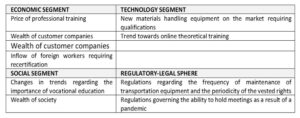
Source: Authors’ own elaboration
The conducted research identified several key factors for action. The most significant of these, by segment, are:
- economic – the influx of foreign workers requiring re-qualification
- technological – the trend of conducting theoretical training online
- social – changes in trends regarding the importance of vocational education
- regulatory-legal – regulations concerning, among others, the timeliness of entitlements.
Strategic potential analysis using SWOT method
What was the research stage that yielded the best results in the area of determining the factors that are also important from the BSC point of view is the SWOT analysis performed for the company (Phadermrod, 2019). Its detailed results are shown in Table 4.
Table 4. SWOT analysis for OSZ
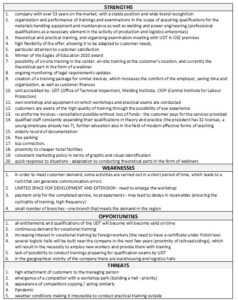
Source: Authors’ own elaboration
In the analysis conducted, by far the largest number of factors were singled out among the strengths of the SWOT analysis. This means that, up to now, the business up has been oriented towards development and ensuring high quality for the customer – most features are concentrated around these areas. The company is prosperous, and its operating conditions are favourable. Among the opportunities, six factors were singled out, centred around the growing demand for specialist training for handling equipment, and related to the location of the company.
Among the weaknesses, only four factors were identified. They focus on the location of the company, which, despite its location in the vicinity of large workplaces, limits development opportunities, especially the expansion of the OSZ. Among the threats, there are factors indicating the threats from potential competitors or resulting from the lack of access to the covered maneuver yard.
Factor maps and correlations
The factors identified through Porter’s five forces analysis, PEST analysis, and SWOT analysis, are broken down into three areas: strategic, progress measurement, and operational, consistent with the BSC assumptions. This division is one of the most common and most recommended (Truong et al., 2020). In order to plan and execute the tasks at the lower levels effectively, it is necessary to design the system properly at the strategic level. Therefore, the map shows only those factors which have connections with the strategic factors (Figure 2.). Performance measurement in the idea of a balanced scorecard is based on a structured set of factors (Huynh, 2020). As a result of the research, three of the four BSC perspectives were identified, and their list was developed accordingly. The individual factors were given alphanumeric codes, where a letter stands for the area, the factor belongs to (S – strategic, P – measurement of the progress, O – operational) and the number is its consecutive order number in the given area. The alphanumeric codes are presented on the maps of connections of factors and in the fifth column (connections) in tables 5, 6 and 7. In the tables, to increase the legibility, only the factors showing connections with the strategic area factors are presented.
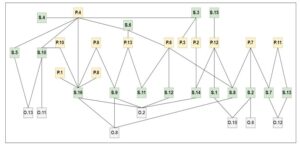
Figure 2. The strategy map for OSZ – breakdown of factors by area: green – strategic, yellow – progress measurement, grey – operational
Source: Authors’ own elaboration
The identified factors were analyzed using the pairwise comparison method. The occurrence of relationships was examined using the expert method with the participation of the authors of the publication and the company’s management. The correlations between the factors indicate that S.16 (competence – in organizing and conducting specialized training and examinations) is particularly important. The number of its connections with other factors suggests that the influence exerted by the factors in direct relation with it had special strategic significance for the company’s activity. The related elements are: profit (P.1), facilities (P.8), developed courses (O.2), innovation (P.10), building a maneuvering hall (P.9) and machinery (O.8). S.16 is important because it is the only element with which there is direct connection to the financial factor – profit (P.1 – increase in company revenue). Neglecting the influence of the factor S.16 may lead to permanent stagnation of the company’s income growth, which may cascade to restricting the possibilities of the functioning and development of the company.
The second factor with an extensive network of relationships is from the area of measurement of the progress of implementation – P.4 (flexibility / machinery – the implementation of training in the OSZ or in the customer’s premises). All six factors with which it is connected belong to the strategic area: location (S.5., S.6. and S.10.), customer relations (S.3. and S.4.) and competence (S.16.). Location issues are a significant advantage for the company. Its location near a developing technology and logistics park ensures the interest of potential customers. However, since it has only one location, the company also offers service delivery at the customer’s premises. This overcomes the territorial barrier and makes it possible to expand the customer base. The possibility to invite trainers to the customer’s premises becomes a significant advantage, because it reduces the time of trained employees’ unavailability.
A summary of all the identified factors with brief characteristics and their interrelationships is presented in Table 5., Table 6. and Table 7. The second column illustrates the belonging of the factor to the different planes defined in the BSC framework. These are respectively: F – financial perspective, C – customer perspective, P – internal processes perspective, D – learning and development perspective. The third column presents the key words that support the identification and grouping of factors. The fourth column is the description of the factor identified as the result of previous analyses. The last column illustrates the relationships between the factors, pointing to factors from the other two areas that show direct links with the described factor.
Table 5. Summary of strategic area factors for OSZ
Source: Authors’ own elaboration
Table 6. Summary of progress measurement area factors for OSZ

Source: Authors’ own elaboration
Table 7. Summary of operational area factors for OSZ
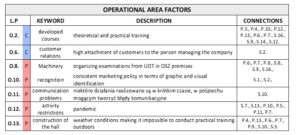
Source: Authors’ own elaboration
Financial perspective
There are only a few factors from this perspective. Only one appears on the map – the growing revenues of the company. They reflect the good condition of the company and customers’ great interest in offered trainings. At the same time, they enable the development of the company, including the new ways of conducting courses and the expansion of the training park.
The customer perspective
What is particularly important for the continuity of the company’s operations is the loyalty of its customers, both in terms of their return and recommending training to others. It helps to establish the base of returning corporate customers that has allowed the OSZ to function in a long-term and stable way in a highly competitive market. Stable position is also built owing to recognizability and identifying the quality of offered trainings with consistent marketing policy. The changing requirements of customers contribute to the continuous development of the company, realized in two ways: the ability to create training packages and the ability to observe training by the customer. Packages are developed according to the individual requirements of corporate customers and offered on attractive terms.
Concentration also occurs around the topics of convenience and flexibility, customer relations, and the number of people trained. One convenience is the possibility of cancelling a service freely, for whatever reason, without the loss of funds. Another is work with certified translators. Non-Polish speaking clients have the opportunity to learn and pass in their native language and the certification of the translator ensures the validity of all information provided.
Efficient communication with customers is also an important aspect. It facilitates lasting relations, which are the basis of long-term cooperation and mutual support in activities. However, the company is currently in the succession phase and its management is to be taken over by sons. As a result, this may reduce the interest of customers, who wanted to maintain contacts primarily because of the quality of training provided personally by the manager.
Internal process perspective
The location of the center is not accidental, being close to large customers and the prospect of attracting more from the nearest area were the main reasons for the location. Unfortunately, despite a very good position on the market, the company has only one head office. There are bug growth prospects, allowing the company to plan expansion also in other locations.
Flexible response to the pandemic situation enabled the rapid resumption of the implementation of theoretical training, which was conducted in the form of remote webinars. Although this required investment in equipment and technology, it brought a very positive response and customers were eager to take advantage of such an offer. As a result of positive evaluations of the training and maintaining the pass rate of the exams, it was permanently included in the OSZ offer.
A diverse and fully accessible fleet of machines is needed for the efficient delivery of training courses, which provides the facility with many customers and is the basis for daily operations. To this end, a project is underway to build a new logistics hall.
Learning and development perspective
Business is shaped to a large extent by the legal requirements of the professions requiring certified qualifications. Regulations in this area are often amended and adapted to the developing sector. What was an important change was the implementation of a limited validity period of certificates granted by the UDT. This means an increase in demand for training, in which, in addition to customers who want to acquire qualifications for the first time, there will be people who will have to re-qualify and renew their certificates.
As the company is a unit accredited by certification bodies, it creates much higher trust of a potential customer. An example of previous activities in this area is the establishment of an agreement with the UDT, according to which examination sessions are held in the OSZ. This is quite convenient for the customer who contacts only the OSZ in order to acquire knowledge and skills and obtain a certificate for them. As a result, the process is shortened from several weeks to one week, during which a full service is provided – from training to examination. The quality of training is also confirmed by the Eagles of Education 2020 award was granted to the OSZ, which is a significant distinction confirming the competences of the educational institution.
The map (Figure 3) shows the correlations of factors by perspective – financial, customer, internal processes, and learning and development. This identification allows us to see the interdependencies and groups of factors in the inter-area dimension (Wu, 2012).
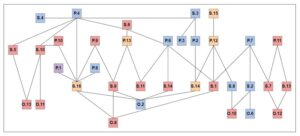
Figure 3: Strategy map for the OSZ – breakdown by BSC perspective
Source: Authors’ own elaboration
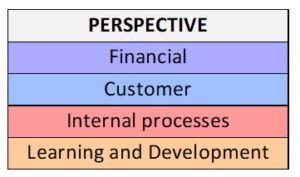
Figure 4: Color code for BSC perspectives
Source: Authors’ own elaboration
Also in this view, S.16 appears as a key factor, related to factors from all other perspectives, which reflects the mission of the company under study, which is to organize and carry out training to acquire specialized qualifications. In the financial perspective, it is associated with an increase in the company’s revenue (P.1). In the customer perspective, we can see the adaptation to their expectations by providing training of both theoretical and practical character (O.2), offering them both in the OSZ, or at the customer’s place (P.4) and allowing non-Polish speaking customers to pass exams (P.8). On the other hand, presenting theory in the form of webinars (P.10), organizing training at the company’s headquarters (O.8) and beginning the construction of a roofed hall for practical training belong to the perspective of internal processes.
The second factor with a differentiated relationship is P.12 – obtaining the Education Eagles 2020 award. This is primarily due to the long-term experience of the surveyed company (S.1 – customer perspective), which pays off in the form of the continuous improvement of qualifications by its employees (S.14 – learning and development perspective), also in the field of modern forms of education (S.15 – learning and development perspective) and obtaining accreditation from the UDT, CIOP and the Welding Institute (S.8 – internal processes perspective).
The factors from the perspective of internal processes reveal the greatest number of connections on the map, which is justified by their number. At the same time, however, it allows one to conclude that changes taking place within them will most significantly influence factors from other perspectives. Those from the group of development and science are in the second place (five factors on the map), and there are significantly fewer of them than the area of internal processes (17), or customer (12). It proves the high importance of this area for the functioning of the researched company.
Conclusion
The issue of monitoring the effectiveness of functioning in a dynamically changing environment is the increasingly frequent subject of interest of entrepreneurs. Many of them decide to implement tools enabling such observations, among others, the Balanced Scorecard proposed for the examined family enterprise. Taking into account the priorities and goals that the company intends to achieve, a dedicated Balanced Scorecard was prepared as a tool to measure the achievements in the best possible way. The result of the conducted research procedure is not only the created Balanced Scorecard, but also a strategy map. Such a combination allows us to precisely visualize the connections between factors, which translates into the better understanding of the content and, ultimately, into the effectiveness of the implemented activities.
First of all, measures were selected to measure achievements within the BSC, thus creating a comprehensive tool. However, in order to observe the long-term effects of its application, it should be noted that change resulting from the improvement of one or several factors is not enough. Only a well-functioning system of related factors (presented in the maps) will allow achieving satisfactory, visible results (Kober and Northcott, 2021). It becomes necessary to develop many of them in parallel and evenly. The achievement of long-term effects resulting from the application of the BSC will be possible in the situation of controlled changes in many related factors. This is illustrated, among other things, by the presented strategy map. Only a well-functioning system of related factors will make it possible to achieve satisfactory, visible results.
Monitoring changes in the factors and the correlations between them, together with the introduction of appropriate metrics, dedicated to the identified factors, will allow the company to keep an eye on the state of the company properly. The development of a system of metrics is the next planned stage of research, the final effect of which is to be the development and implementation of a dedicated Balanced Scorecard in the OSZ.
References
- Ho J. K-K. (2014) ‘Formulation of a systemic PEST analysis for strategic analysis’, European Academic Research Vol. II, Issue 5, pp. 6478 – 6492
- Huynh T.T-M., Dang Ch.N., Le-Hoai L., Pham A-D., Nguyen T.D. (2020) ‘Proposing a strategy map for coastal urban project success using the balanced scorecard method’, Engineering, Construction and Architectural Management Vol. 27 No., pp. 2993-3030
- Isabelle D., Horak K., McKinnon S., Palumbo Ch. (2020) ‘Is Porter’s five forces framework still relevant? A study of the capital/labour intensity continuum via mining and IT industries’, Technology innovation management review, Vol.10 (6), pp. 28-41
- Kaplan, R. S. and Norton, D. P. (2001) ‘Strategic scorecard. How to translate strategy into action? (second edition)’, Warsaw: PWN, pp. 28, 42-45
- Kober R., Northcott D. (2021) ‘Testing cause-and-effect relationships within a balanced scorecard’, Accounting & Finance vol. 61, pp. 1815–1849
- Łada, M. and Kozarkiewicz, A. (2007) ‘Management accounting and project controlling’ Warszawa, Publisher C.H. Beck, pp. 62
- Malagueño R., Lopez-Valeiras E., Gomez-Conde J. (2018) ‘Balanced scorecard in SMEs: effects on innovation and financial performance’, Small business economics, Vol.51 (1), pp.221-244
- Massingham R, Massingham P.R., Dumay J. (2019) ‘Improving integrated reporting: A new learning and growth perspective for the balanced scorecard’, Journal of Intellectual Capital Vol. 20 No. 1, pp. 60-82
- Mazurek, G., Nosalska, K. (2018) ‘The use of content marketing in the B2B industrial market – empirical research’, Marketing and Market (4), pp. 408.
- Oliveira C., Oliveira A. Fijałkowska J., Silva R. (2021) ‘Implementation of Balanced Scorecard: case study of a portuguese higher education institution’, Management, Vol. 26, No. 1, pp. 169-188
- Osunsanwo H.F., Dada J.O. (2020) ‘Evaluating quantity surveying firms’ performance: An application of balanced scorecard technique’, International Journal of Productivity and Performance Management Vol. 69 No. 1, pp. 134-152
- Phadermrod B., Crowder R.M., Wills G.B. (2019) ‘Importance-performance analysis based SWOT analysis’, International journal of information management, Vol.44, pp.194-203
- Sainaghi R., Phillips P., d’Angella F. (2019), ‘The balanced scorecard of a new destination product: Implications for lodging and skiing firms’, International journal of hospitality management, Vol.76, pp.216-230
- Truong D.D., Nguyen H., Duong T.Q.L. (2020) ‘Factors influencing Balanced Scorecard application in evaluating the performance of tourist firm’, Journal of Asian Finance, Economics and Business Vol 7 No 5, pp. 217 – 224
- Tuan T.T. (2020) ‘The impact of Balanced Scorecard on performance: the case of vietnamese commercial banks’, Journal of Asian Finance, Economics and Business Vol 7 No 1, pp. 71-79
- Więcek-Janka E. (2019) ‘Conflicts in the management of family businesses, concepts, models, tools’, Publishing house of the Poznan University of Technology
- Wu H-Y. (2012) ‘Constructing a strategy map for banking institutions with key performance indicators of the balanced scorecard’, Evaluation and program planning, Vol.35 (3), pp.303-320













